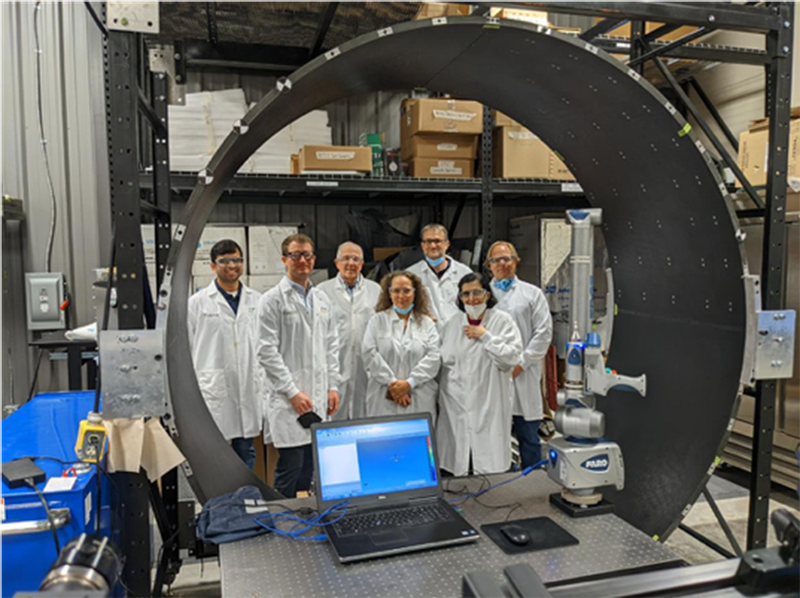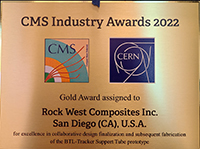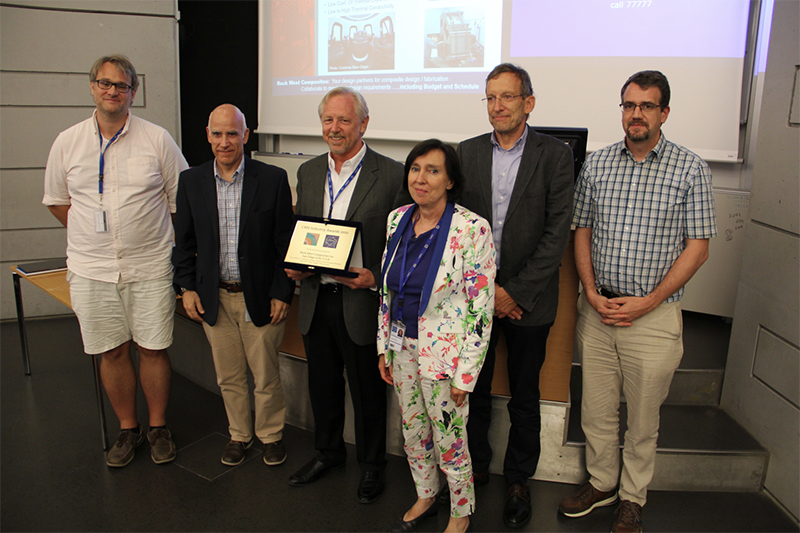Award winning prototype’s successful review leads to $1.5M manufacturing funding for CMS detector
2022-08-30

A large carbon fiber prototype destined for CERN in Switzerland was created by a team of researchers led by Dr. Andreas Jung, associate professor of Purdue Physics and Astronomy. Last winter, these eight foot wide carbon fiber tubes were created in hopes that they would be a good fit for the Large Hadron Collector (LHC) in the CMS detector. The fiber tube slides into the CMS detector’s calorimeter, the heart of the CMS. The team has now demonstrated that the project is successful and passed the Department of Energy’s (DOE) CD-3b round. This successful passage will yield funding of roughly $1.5 million for Purdue University to manufacture the final product.
 As a result of the funding, the team and Purdue University and their manufacturing partners at Rockwest Composites were awarded the CMS Gold award. According to CMS, six industrial companies were awarded with “Gold Awards” this year for their excellent contributions to the upgrades of the different CMS sub-detectors. The projects were related to both the detector’s recent upgrade phase- Long Shutdown 2 and the future upgrade phase: High-Luminosity LHC. The Purdue and Rockwest team was awarded for excellence in collaborative design finalization and subsequent fabrication of the BTL-Tracker Support Tube prototype.
As a result of the funding, the team and Purdue University and their manufacturing partners at Rockwest Composites were awarded the CMS Gold award. According to CMS, six industrial companies were awarded with “Gold Awards” this year for their excellent contributions to the upgrades of the different CMS sub-detectors. The projects were related to both the detector’s recent upgrade phase- Long Shutdown 2 and the future upgrade phase: High-Luminosity LHC. The Purdue and Rockwest team was awarded for excellence in collaborative design finalization and subsequent fabrication of the BTL-Tracker Support Tube prototype.
“This Gold Award from CMS means a great deal,” says Jung. “We won the award and can now carry out this project at Purdue (and Rockwest) for the next roughly 1.5 - 2 years. It will fund engineers, technicians, and undergraduate students involved in the project here at Purdue. It also makes Purdue highly visible at the international level since we are the only one who can deliver and finish the project as determined by the review. Purdue is the place to be for this kind of large composite design and manufacturing in basically the entire world since CMS collaboration has more than 150 institutes and national labs from all over the world.”

The team needed to work with a manufacturing partner due to the complexities of creating these large carbon fiber structures.
“We worked collaboratively on the prototype and will do so in the future for the full-sized structure,” says Jung. “Outside manufacturing is driven by a lack of large enough equipment here at Purdue. For example, the tubes need a curing oven of 2.5m x 7m or 9 feet x 24 feet!”
Now that the project has been successfully demonstrated, the team will start working on the manufacture of the carbon fiber tube that will be installed inside the CMS detector as part of the High-Luminosity upgrade of the LHC. The whole process is expected to take 18 months. Expected completion of the project is Spring 2024. The smaller prototype built last fall will serve as the model for the much larger carbon fiber tube.
“The new version is more demanding in terms of tolerances and performance,” says Jung. “The prototype is too small to be used in the actual CMS detector. Instead, we performed tests at Purdue to resemble the environment in the detector during installation and detector operation. There is still a potential for the prototype to be shipped to CERN for installation tests only. This would basically just be installation 'dry-runs' to prepare for the future installation work, which is beneficial due to the complexity inside the CMS detector.”
About the Department of Physics and Astronomy at Purdue University
Purdue Department of Physics and Astronomy has a rich and long history dating back to 1904. Our faculty and students are exploring nature at all length scales, from the subatomic to the macroscopic and everything in between. With an excellent and diverse community of faculty, postdocs, and students who are pushing new scientific frontiers, we offer a dynamic learning environment, an inclusive research community, and an engaging network of scholars.
Physics and Astronomy is one of the seven departments within the Purdue University College of Science. World class research is performed in astrophysics, atomic and molecular optics, accelerator mass spectrometry, biophysics, condensed matter physics, quantum information science, particle and nuclear physics. Our state-of-the-art facilities are in the Physics building, but our researchers also engage in interdisciplinary work at Purdue’s Discovery Park, particularly the Birck Nanotechnology Center and the Bindley Bioscience Center. Furthermore, we participate in global research including at the Large Hadron Collider at CERN, Argonne National Laboratory, Brookhaven National Laboratory, Fermilab, the Stanford Linear Accelerator, the James Webb telescope, and several observatories around the world.
Writer: Cheryl Pierce, Communications Specialist
Contributor: Dr. Andreas Jung, Associate Professor of Physics and Astronomy
Photos provided by Dr. Andreas Jung